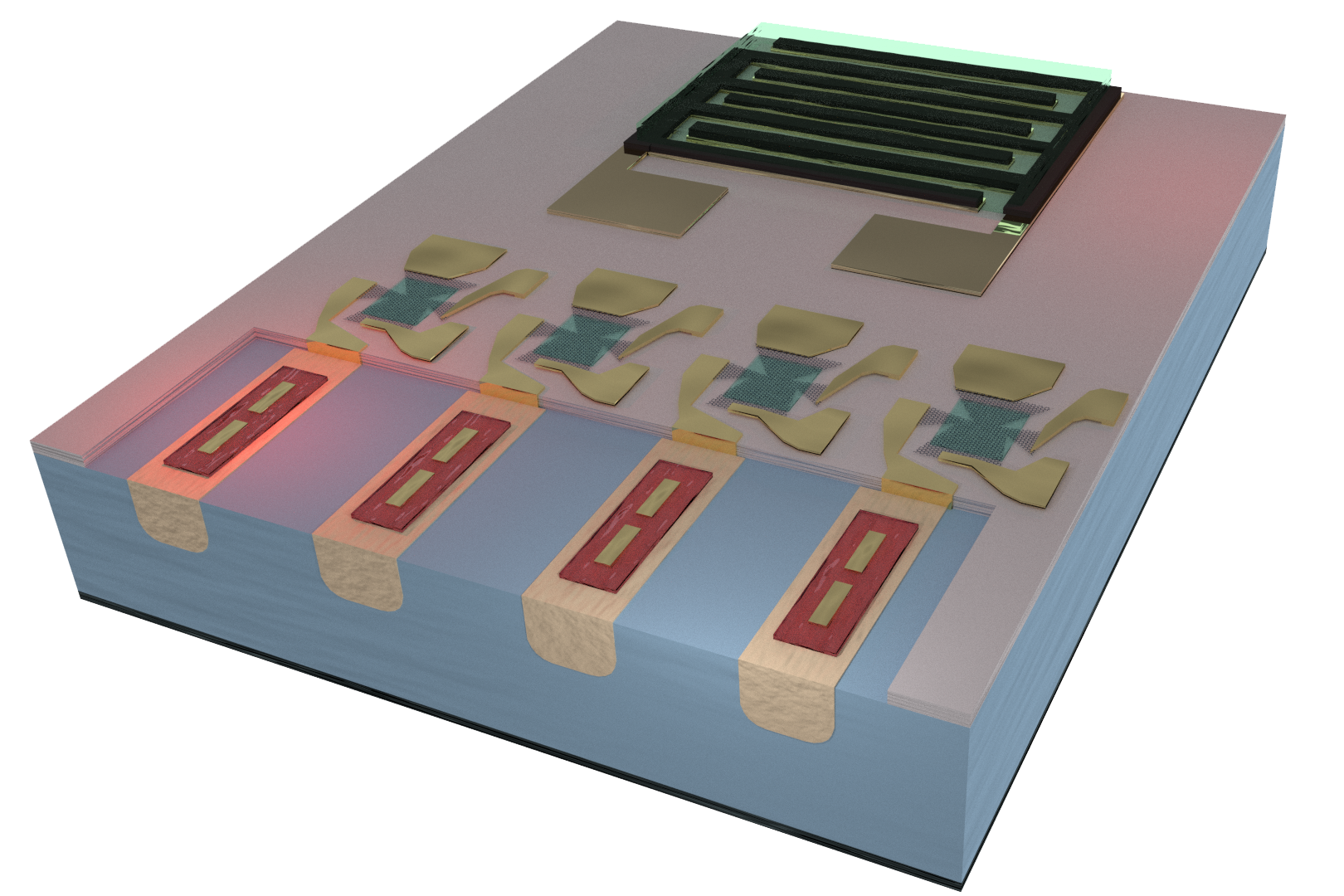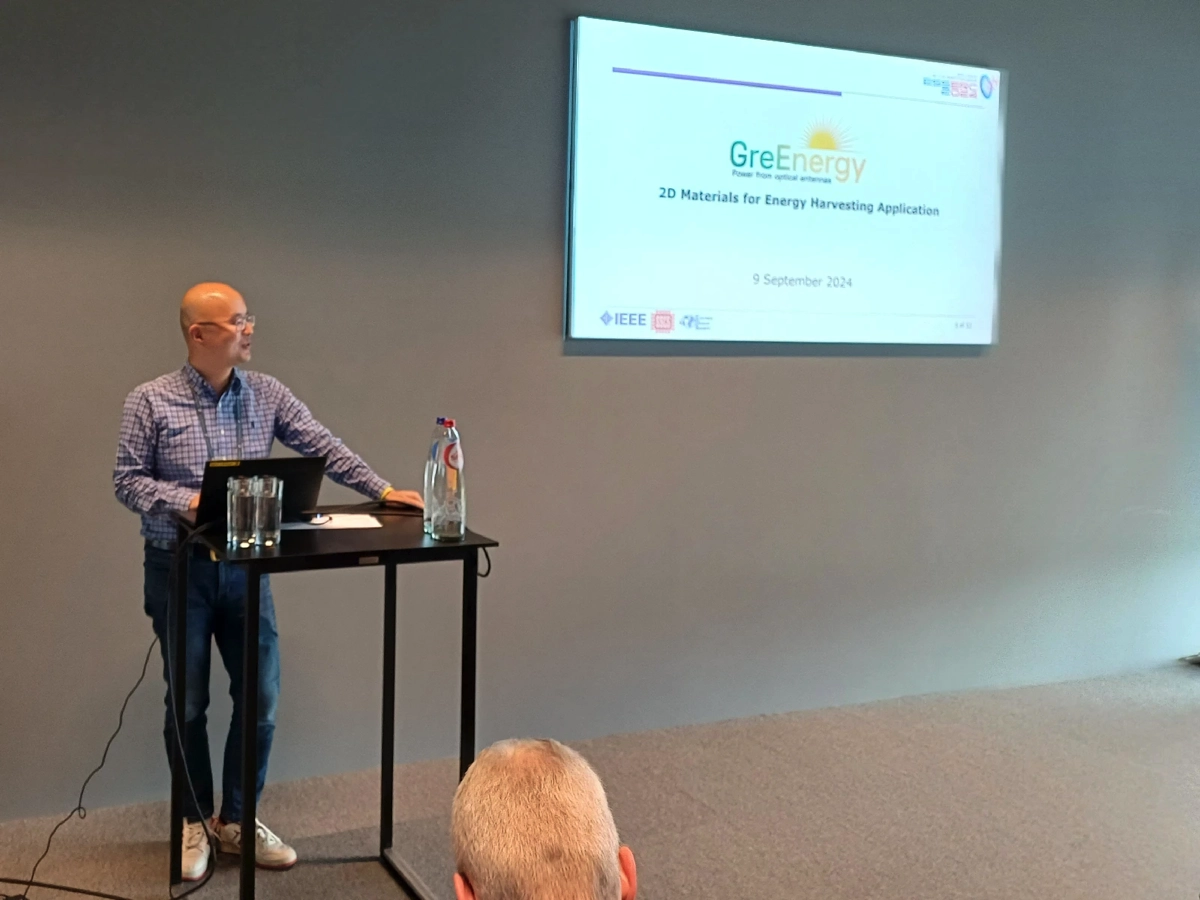
Energy, crucial for human needs and national growth, often relies on inefficient and environmentally damaging sources. Solar power, promising clean and abundant energy, remains underutilized, generating below 5% of global electricity.
Project GreEnergy seeks to revolutionize solar energy with a high-efficiency optical antenna array, integrating nano-components for self-powering systems. Prototyping includes nano-optical antennas, rectifiers, and micro-energy storage, paving the way for single-chip fabrication. This innovation could transform energy production, benefiting consumers, society, and the environment, while laying groundwork for future micro/nano-systems.
The workshop provided an overview of the project, covering various aspects such as simulation, design, device fabrication, energy storage, and system impedance matching.

All times are in CEST
GreEnergy project is a breakthrough systematic approach to harvest sun light energy. GreEnergy research is focused on sun light energy harvesting using a nano antenna and nano rectifier (rectenna) with an extremely high efficiency potential (more than the conventional PV cells). The presentation will focus on the challenges of such an approach.
Dr. Avi Ginzburg is currently a Senior Scientist in AMO GmbH Germany. Dr. Ginzburg holds a BSc. in Electrical Engineering, MSc. Nuclear Engineering and PhD in Systems Engineering. He has an extensive experience in industrial position of Vice President for Research and Development of large corporations.
Graphene geometric diodes are promising elements for the design of energy harvesting devices, to be integrated onto a chip together with the energy storage components. In this talk we will discuss four different methods of modelling charge transport in two and three terminal geometric diodes: DFT based, Montecarlo, Scattering Matrix and Drift Diffusion. These approaches are all very different with different assumptions
Davide Mencarelli received the Laurea and Ph.D. degrees in electronic and telecommunication engineering from University Politecnica of Marche (UNIVPM), Ancona, Italy, in 2002 and 2005, respectively, and the graduate degree for enabling Professional Engineer, in 2006. Since 2014, he has been an Assistant Professor with the Department of Information Engineering, UNIVPM. His research interests include coherent charge transport in low dimensional systems, photonic crystals, nano–field effect transistors (nano-FET), planar slot array antennas and microwave components, scanning probe microscopy (SPM), optomechanics, and phononic devices.
Graphene ballistic diodes are very promising devices due to the long mean free path that can be achieved in this material even at room temperature. Accurate transport modeling tools are required to properly design these diodes. In this talk, we will discuss the Monte Carlo simulation technique and explore the physical mechanisms of rectification in ballistic diodes.
Prof. Michele Midrio received his PhD in Telecommunication Engineering from Università di Padova in 1994. Since 1999 he has been a professor of Electromagnetic Wave Theory at the University of Udine. His research interests are in high-speed optoelectronic devices for data and telecom, design of antennas both at conventional and optical frequencies, and modeling of electronic transport in 2D materials. Prof. Midrio has published nearly 200 peer-reviewed articles and contributions to conferences.
An elementary model of a device and the practical feasibility of integrating a magnetic layer into this device were presented. Non-reciprocal effects such as Verdet (in insulators in optics), circulators in microwave technology or the effect of the Lorenz force on the charges in a single graphene layer can be used to introduce direction-dependent variations in charge transport, enhancing the I-V asymmetry in rectifiers. This could lead to more efficient, tuneable, and high-performance graphene-based electronic devices.
Dr. Yuval Shlomo bar Yossef (a.k.a. Flavio Fontana) obtained the Italian “Laurea” degree in Nuclear Engineering summa cum laude from the Polytechnic Institute of Milan in 1984. As a researcher and later R&D manager of Pirelli Cavi S.p.A. in Milan, he participated from the very beginning to the development of the 980nm-pumped Erbium-doped fiber amplifier in the embodiments still universally used nowadays and pioneered the field of ultrafast fiber lasers sources and telecommunications. He coordinated since 1998 the kick-off of the Pirelli Labs, the most important nanophotonics laboratory in Italy. After having moved to Israel in 2012, he owns the consultancy firm NOGAH PHOTONICS Ltd., involved in several projects on optical design, integrated photonics and fundamental physics.
Two-dimensional materials are promising candidates for energy harvesting devices. In this talk we focused on rectennas for electromagnetic radiation harvesting. Graphene-based devices, in particular, have been shown to rectify signals up to THz frequencies. However, minimizing parasitic RC components will be required to maximize the efficiency of the energy harvesting systems. Wafer-scale fabrication in existing semiconductor platforms is a serious engineering problem but probably not a basic scientific roadblock. There are ample examples that indicate that a technology based on two-dimensional materials can play a unique role for future electronic systems.
Dr. Zhenxing Wang obtained his Ph.D. degree in 2012 from Peking University in China, on the topic of carbon-nanotube- and graphene-based radio-frequency electronics. After that he joined University of Erlangen-Nuremberg as a postdoctoral researcher, working on solution-based 2D-materials-based nanodevices. From 2014 he has been with AMO, where he is responsible for development of graphene-based electronics, especially for high-frequency applications. Now he is the head of the Graphene Electronics Group at AMO GmbH.
It is challenging to achieve a terahertz speed by conventional electronic devices due to their often vertical structures and parallel electrodes, which result in large parasitic capacitance. A couple of novel device structures are developed based on planar architecture, with their electrodes placed on the sides. Furthermore, such devices are insensitive to material bandgap, and hence can be fabricated with 2D materials such as graphene.
Prof. Aimin Song received PhD in physics 1995. He became a full Professor in Nanoelectronics at the University of Manchester in 2006. He has published over 200 journal articles and contributed over 100 invited talks at international conferences. He received a Distinguished Achievement Medal for “Researcher of the Year” of the University of Manchester. His research interest includes novel nanoelectronic devics and thin film electronics.
Mixed-dimensional van der Waals (vdW) heterostructures are promising for research and technological advances in photonics and optoelectronics. Here we report vdW epitaxy of one-dimensional InP nanowires (NWs) directly on two-dimensional MoS2. Due to the unique properties of both materials, strong linear and nonlinear optical responses from the heterostructures is observed. In addition to strong 2nd and 3rd harmonic responses, the heterostructures show odd-order high harmonic generation up to 7th order.
Prof. Harri Lipsanen received his PhD in physics from Helsinki University of Technology in 1994. Since 1999 he has been a Professor of Nanotechnology in Aalto University. He studies nanomaterials and nanofabrication for various applications in photonics and nanoelectronics. His current research focus on materials includes graphene and other 2D materials, compound semiconductor nanowires and heterostructures. Prof. Lipsanen has published over 400 peer-reviewed articles and supervised 33 PhD students.
The potential advantages of using electrochemical capacitors (ECs) for electrically based energy storage compared to rechargeable batteries lie in part in superior cyclability and higher power density. In a system that would rely on energy harvested from the environment to provide the power required for its functionality, there are however some challenges when wanting to integrate ECs. We will address the trade-offs with regards to losses related to ECs for particularly relevant applications in this presentation.
Prof. Per Lundgren received his PhD in solid state electronics from Chalmers University of Technology in 1996. Since 2021 he has been a Professor in Electronics Materials Education at Chalmers. His current research includes work on self-powered mirosystems employing microelectromechanical harvesters and electrochemical energy storage. Prof. Lundgren has over 100 peer-reviewed articles and has supervised 11 PhD students.
Energy harvesters are one of the solutions of the immense energy needs by harvesting abundant energy from the environment. It is extremely important to deliver the harvested energy with minimum losses to achieve high efficiency. In this perspective, circuit design plays an important role in the energy harvesters. From the selection of the simulation environment to the realization of the circuits, a detailed approach should be followed.
Corrado Carta received the master's degree in electrical engineering from the University of Cagliari, Italy, in 2000, and the Ph.D. degree from the Swiss Federal Institute of Technology (ETH) Zurich, Switzerland, in 2006. From July 2000 to February 2006, he was with the Microwave Electronics Group at ETH Zurich, where his main research interests were in the field of silicon radio frequency integrated circuit (RFIC) design for microwave wireless communications. From April 2006 to May 2008, he was with the High-Speed Electronics Group, Department of Electrical and Computer Engineering, University of California at Santa Barbara, CA, USA, where his research work focused on the design of silicon integrated circuits for very large mm-wave phased arrays. In June 2008, he joined Sonos, Inc., Santa Barbara, where he led the RF Engineering and Compliance Team, involved in the development and characterization of the wireless interface of new and existing products. In March 2010, he joined the Chair of Circuit Design and Network Theory, Technische Universität Dresden, Germany, where he lead the mm-Wave IC Design Group and the Beyond-Moore Electronics Group. Since September 2022 he is a Professor at the Technische Universität Berlin, chair of Broadband and High-Frequency Integrated Circuits, with a joint appointment as Head of the Circuit-Design Department of IHP Microelectronics, Frankfurt (Oder), Germany, conducting research on a wide range of topics, including integrated microwave and millimeter-wave circuits, broadband mixed-signal circuits and high-efficiency circuits for communication and sensor applications.
Assoc. Prof. Per Rudquist received his PhD from Chalmers University of Technology in 1997. He is at Department of Microtechnology and Nanoscience, division of Electronics Materials Systems at Chalmers. In 2010 he was awarded the Arnbergska Prize from the Royal Swedish Society for his work on polar liquid crystals. His present research focuses on electric and electrooptic properties of liquid crystal materials systems. Since November 2023 he is coordinator of the GreEnergy project.
* Due to last-minute obstacles, the presentation intended by Dr. Yuval bar Yossef was given by Davide Mencarelli and the one intended by Per Lundgren by Per Rudqvist